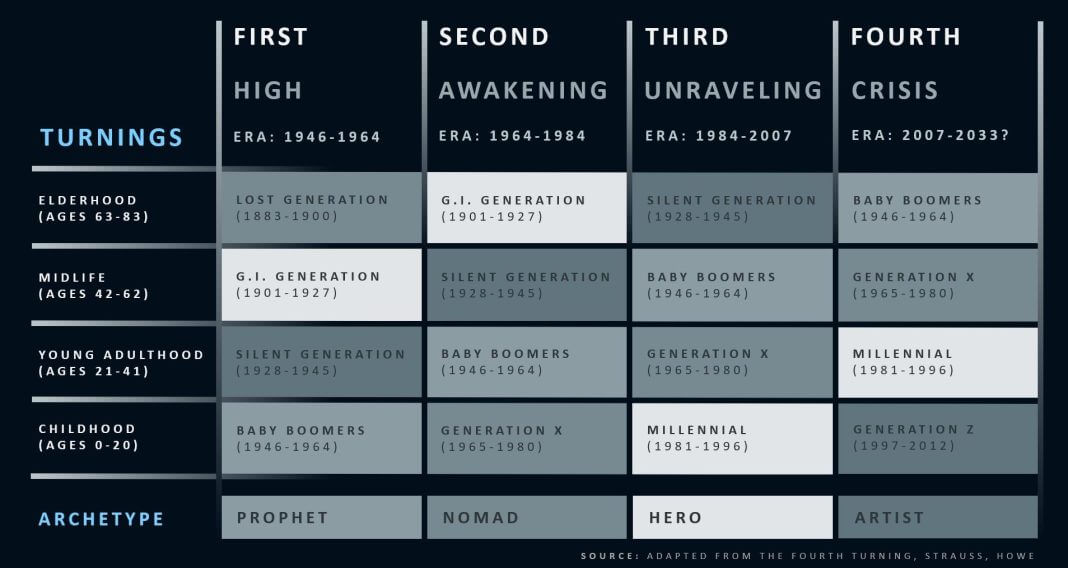Texas Nationalist Movement President Daniel Miller sent a clear signal to supporters Saturday evening: the unfolding Fourth Turning crisis represents a generational opportunity for Texas independence, and TNM must position itself strategically for what he sees as the inevitable dissolution of federal authority.
Miller’s weekend email referenced a comprehensive analysis exploring how the current societal upheaval fits the Strauss-Howe Fourth Turning pattern—an 80-year cycle of crisis that historically destroys old orders and creates new ones. His message was succinct but loaded with strategic implications: “Imagine a scenario where Texas independence occurs naturally as a result of the Fourth Turning resolution. One possible outcome. Be ready.”
The timing reflects TNM’s sophisticated understanding of historical patterns that Miller has articulated in previous speeches. Rather than viewing current political chaos as random events, Miller frames the crisis as part of predictable generational cycles that create windows for fundamental political realignment.
The Fourth Turning analysis Miller highlighted paints multiple resolution scenarios for America’s current crisis, expected to climax by the early 2030s. The most likely outcome described isn’t violent civil war but “exhausted dissolution”—states simply stopping compliance with federal authority as Washington becomes irrelevant, similar to the Soviet Union’s peaceful collapse.
This aligns perfectly with TNM’s constitutional approach to independence. Miller has consistently emphasized that Texas doesn’t need to fight its way out of the Union—it needs to build the political infrastructure to walk away when federal institutions lose legitimacy. The Fourth Turning framework suggests that moment approaches rapidly.
The strategic calculation becomes clear when examining current trends. Federal debt exceeding $37 trillion, institutional trust collapsing across government agencies, and generational political realignment all point toward the kind of comprehensive breakdown that historically enables new political arrangements.
Miller’s reference to being “ready” isn’t accidental. TNM has spent years building the organizational capacity needed to capitalize on such opportunities. The movement has established county-level chapters, developed legislative strategies for independence referendums, and created the political networks necessary for a peaceful transition.
The Fourth Turning analysis emphasizes that current crises differ from previous ones due to technology’s role. Information warfare, digital surveillance, and algorithmic manipulation create unprecedented challenges—but also opportunities for decentralized movements that understand these dynamics.
For Texas independence advocates, this technological dimension offers advantages. Global patterns show that secession movements worldwide are gaining momentum as centralized authorities lose control over information and narrative. Texas, with its distinct identity and economic strength, sits uniquely positioned to benefit from these trends.
Miller’s strategic thinking reflects what Fourth Turning theorists call “water finding a way”—political movements adapting to structural changes rather than fighting them. As federal overreach accelerates and regional polarization deepens, Texas nationalism becomes less radical and more practical.
The institutional breakdown described in the Fourth Turning analysis creates specific opportunities for Texas. When federal agencies lose credibility, when Congress becomes dysfunctional, when the Supreme Court’s legitimacy gets questioned—these aren’t threats to Texas sovereignty but enablers of it.
TNM’s approach emphasizes preparation over reaction. While other political movements focus on winning the next election, Miller positions Texas independence as the inevitable result of systemic forces beyond any single political leader’s control. This long-term perspective explains TNM’s steady growth despite changing political winds.
The Fourth Turning framework suggests resolution comes through either renewal or replacement. Miller clearly believes peaceful Texas independence represents the replacement option—not destroying America but allowing it to evolve into something more sustainable through voluntary dissolution.
This perspective reframes Texas independence from reactive separatism to proactive nation-building. Rather than fleeing federal tyranny, Texas would be pioneering post-federal governance models that other regions might follow. The Fourth Turning becomes not just crisis but opportunity for political innovation.
Miller’s weekend message signals TNM’s readiness to accelerate organizing efforts as crisis conditions intensify. The movement understands that historical windows for fundamental change don’t stay open indefinitely. When institutional legitimacy collapses, prepared movements can shape what replaces it.
For Texas sovereignty advocates, the Fourth Turning analysis validates what many have sensed intuitively: current political arrangements aren’t sustainable, and alternatives must be ready when they fail. Miller’s strategic positioning suggests TNM intends to be that alternative, prepared to guide Texas through peaceful independence when the moment arrives.


